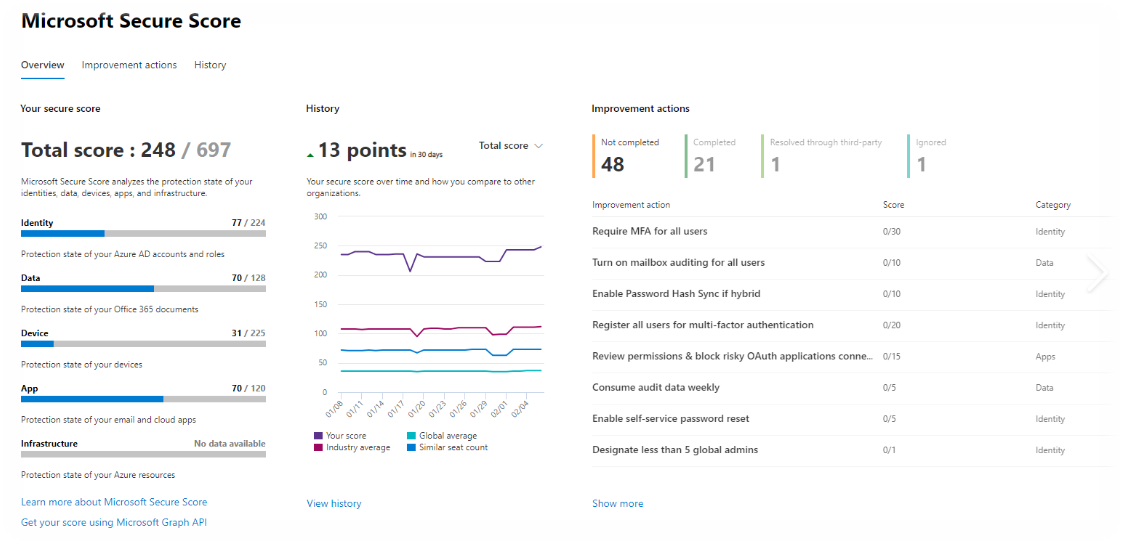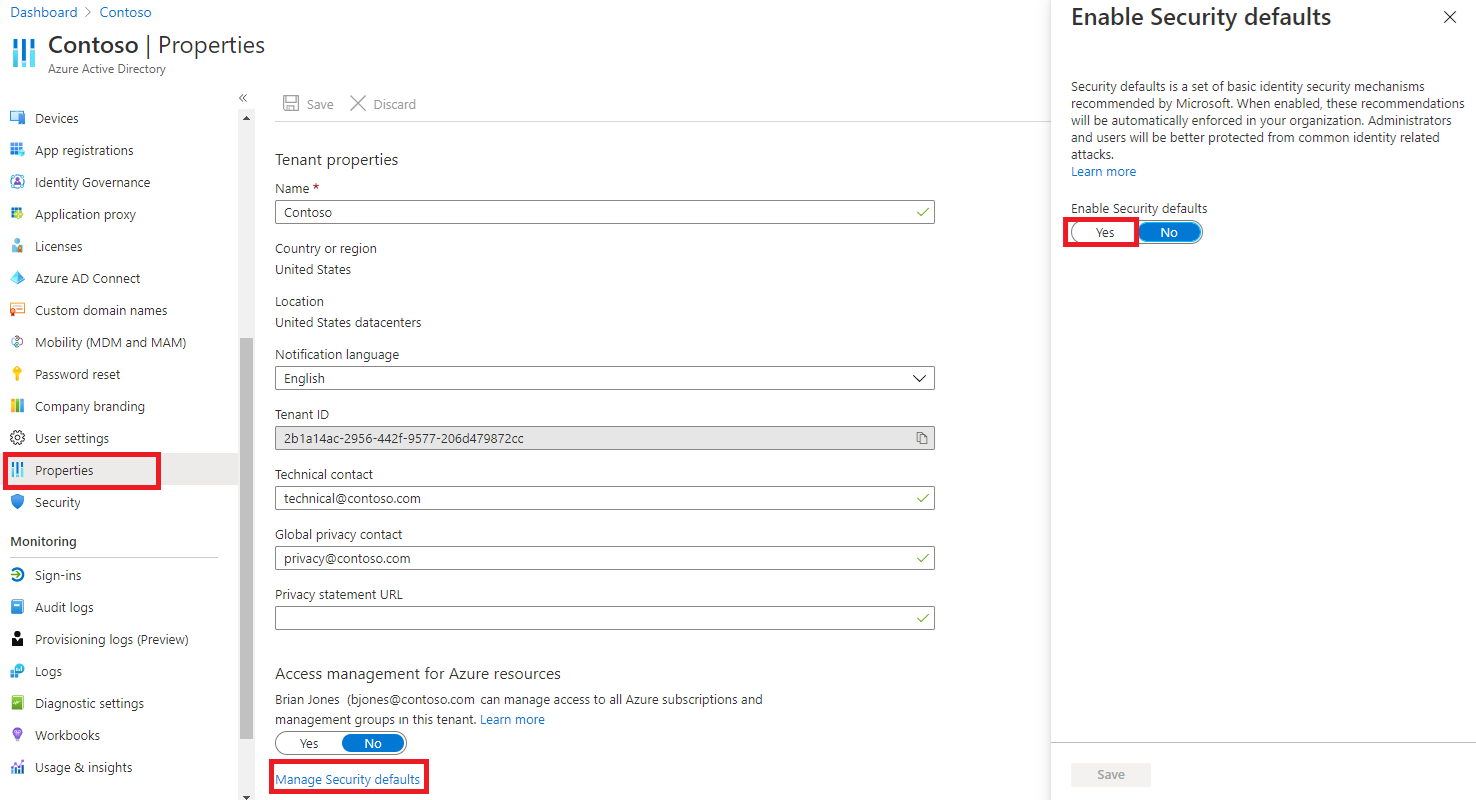In the last post, we discussed Office 365 and how enabling certain features without understanding all the components can lead to a false sense of security. We demonstrated how implementing a break glass account, multi-factor authentication (MFA), and the removal of legacy authentication can help secure your users and point your organization’s security posture in the right direction. While implementing those controls is an excellent start to hardening your environment, it is just the beginning. Read that blog here.
Security is critical, and any way that we can expedite threat prevention is highly welcomed. What if there was a way to get into a more secure state quickly. How much time would this give you back to focus your attention on other tasks like actual customers (user base, clients)?
Do you wish there was a quick approach for security configurations in Azure Active Directory (Azure AD) and Office 365? I know I do, and thankfully we have some options here, and they are Secure Score and security defaults. Many of our customers are not aware that these features exist, or if they are aware, they fail to take advantage of using them.
“This blog post will provide an overview of Microsoft Secure Score and security defaults—two features that are easy to utilize and can significantly improve your security in Azure AD and Office 365 configurations.”
What is Microsoft Secure Score? I am glad you asked
Microsoft Secure Score is a measurement developed to help organizations understand where they are now and the steps needed to improve their security posture. Microsoft Secure Score summarizes the different security features and capabilities currently enabled and provides you with the ability to compare your Score with other companies like yours and identify recommendations for areas of improvement.
Figure 1: Microsoft Secure Score screen image
How does Secure Score help organizations?
Secure Score provides recommendations for protecting your organization from threats. Secure Score will:
- Objectively measure your identity security posture.
- Plan for security improvements.
- Review the success of your improvements.
- The Score can also reflect third-party solutions that have been implemented and have addressed recommended actions.
- The Secure Score reflects new services, thus keeping you up to date with new features and security settings that should be reviewed and if action on your part.
How is the Score determined?
Secure Score compares your organization’s configuration against anonymous data from other organizations with similar features to your organization, such as company size. Each improvement action is worth ten points or less, and most are scored in a binary fashion. If you implement the improvement action, like require MFA for Global Administrators or create a new policy or turn on a specific setting, you get 100 percent of the points. For other improvement actions, points are given as a percentage of the total configuration.
For example, an improvement action states you get ten points by protecting all your users with multi-factor authentication. You only have 50 of 100 total users protected, so that you would get a partial score of five points.
Additionally, your score will drop if routine security tasks are not completed regularly or when security configurations are changed. It will provide directions to the security team about what has changed and the security implications of those changes.
What are security defaults?
Security defaults, a one-click method for enabling basic identity security in an organization, are pre-configured security settings that help defend organizations against frequent identity-related attacks, such as password spray, replay, and phishing. Some of the critical features of Security Defaults include:
- Requiring all users to register for Azure AD Multi-Factor Authentication (MFA) using the Microsoft Authenticator app.
- Requiring administrators to perform multi-factor authentication.
- Blocking legacy authentication protocols.
- Requiring users to perform multi-factor authentication when necessary.
- Protecting privileged activities like access to the Azure portal.
When should you use security defaults?
It would be best if you used security defaults in the following cases:
- If you want to increase the overall security posture and don’t know how or where to start, security defaults are for you.
- If you are using the free tier of Azure Active Directory licensing, security defaults are for you.
How is the Score determined?
Microsoft Secure Score has recently added improvement actions to support security defaults in Azure Active Directory, making it easier to help protect your organization with pre-configured security settings for frequent attack vectors.
When you turn on security defaults, you will be awarded full points for the following improvement actions:
- Ensure all users can complete multi-factor authentication for secure access (nine points).
- Require MFA for administrative roles (ten points).
- Enable policy to block legacy authentication (seven points).
Get Started with Microsoft Secure Score and security defaults
Microsoft organizes Secure Score improvement actions into groups to help you focus on what you need to address for your organization:
- Identity (Azure AD accounts and roles).
- Data (Microsoft Information Protection).
- Device (Microsoft Defender ATP, known as Configuration score).
- Application (email and cloud apps, including Office 365 and Microsoft Cloud App Security).
- Infrastructure (no improvement actions for now).
Secure Score
- Start by logging into your Secure Score.
- View your scores and where you need to improve.
- Export all recommendations for your organization and turn this into an attack plan.
- Prioritize the recommendations you will implement over the next 30, 60, 90, and 180 days.
- Pick the tasks that are priorities for your organization and work these into your change control processes.
Security defaults
- Start by logging in to your Azure portal as a security administrator, Conditional Access administrator, or global administrator.
- Browse to Azure Active Directory, and then Properties.
- Select Manage security defaults.
- Set the Enable security defaults, then toggle to Yes.
- Select Save.
Figure 2: Enabling security defaults
There are many security enhancements that keep coming to Microsoft’s Cloud stack, so be sure you check your secure Score weekly. As the days go by and new security settings appear, your secure Score will reflect these changes. It is critical to check back often to ensure you are addressing any further recommendations.
Bumps in the road
Microsoft Secure Score and security defaults are straight forward ways to evaluate and improve your Azure AD and Office 365 configurations’ security. Security defaults help implement industry recommended practices, while Microsoft Secure Score creates a hands-on interface that simplifies the ongoing process of security assessment and improvement.
Our upcoming blog will explore the necessary built-in Azure tooling and open-source options that an organization can employ during investigative scenarios.
To learn more about Microsoft Security solutions visit our website. Bookmark the Security blog to keep up with our expert coverage on security matters. Also, follow us at @MSFTSecurity for the latest news and updates on cybersecurity.
The post A “quick wins” approach to securing Azure Active Directory and Office 365 and improving your security posture appeared first on Microsoft Security.

